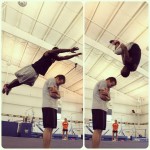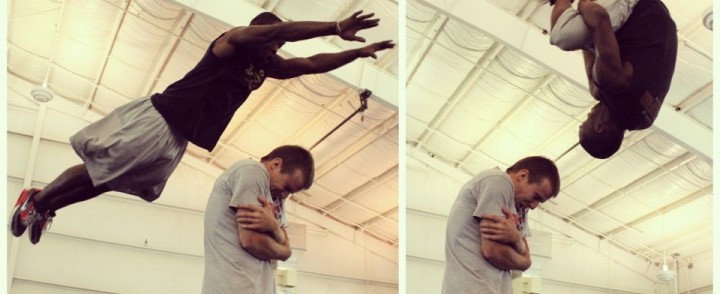Mind and Body Medicine: Meditation!
 Ozell Williams has always been a man in motion. When not cheering at games or competing with his squad at the University of Colorado – Boulder, Williams is entertaining Denver Broncos fans with his power tumbling team, the Mile High Tumblers. Though stillness doesn’t come naturally for the college junior and Tumblers’ founder/CEO, Williams swears by regular meditation—a habit he says helps to heal his body, recharge his mind and optimally manage his multiple endeavors.
Ozell Williams has always been a man in motion. When not cheering at games or competing with his squad at the University of Colorado – Boulder, Williams is entertaining Denver Broncos fans with his power tumbling team, the Mile High Tumblers. Though stillness doesn’t come naturally for the college junior and Tumblers’ founder/CEO, Williams swears by regular meditation—a habit he says helps to heal his body, recharge his mind and optimally manage his multiple endeavors.
“To connect with others, you need to learn how to tap into your emotions, but first you need to learn to connect with yourself,” says Williams. “Meditation helps me do that.”
So what is meditation, exactly? Put simply, meditation is the practice of calming the mind in order to achieve a state of deep contentment and/or reflection. (Translated from Sanskrit, the term means “peacefully abiding.”) For nearly half a century, Westerners have known about meditation, but many still don’t fully understand the practice or its benefits. Scientific studies show that meditating can decrease stress and burnout; enhance creativity; promote relaxation and restful sleep; and maximize oxygen efficiency.
“Meditation is one of the best tools we have to go beyond the mind’s noisy chatter and experience the peace of present moment awareness,” says Kyla Stinnett, a certified primordial sound meditation instructor at the Chopra Center in Carlsbad, California. Intrigued? Get a primer on achieving this mystical mindset:
Dispel preconceived ideas. The uninitiated may believe meditation involves sitting cross-legged on a mountaintop for hours on end. Not so, says Michael Miller, who operates meditation centers in New York and London. “Meditation is very much for the modern world,” he says. “People often think meditation is having to adopt a philosophy, belief system or religion—but it’s a simple mental technique.”
Indirectly, meditation can help coaches and gym owners become better role models for athletes—offering a prime example of good self-care, adds Miller.
No incense or candles needed. University of Connecticut alumna Kimberly Daniels had accumulated a laundry list of injuries during her days as a cheerleader and UCA camp instructor. In 2000, she discovered meditation, which not only nourished her mind but also diminished the pain from her cheering-related injuries.
Now a meditation teacher, Daniels indicates that the practice can be done almost anywhere for any length of time. “Try to find a comfortable place, close your eyes and focus on the breath. Listen to the sound of each inhale and exhale, acknowledging thoughts but letting them go,” she says.
While daily practice is ideal, Daniels notes that in today’s overscheduled world, it’s necessary to be flexible. When time poses a challenge, a quiet nature walk is better than nothing. “You could even meditate for five minutes in the car on your way to cheer practice,” she adds. “See what works for you. Once you start making time for meditation and you skip a day or two, you really miss it.”
Carve out some downtime. Williams manages to incorporate meditation at least twice a day, often when relaxing in the steam room. “I listen to music and relax my body, going into my deepest thoughts,” he says. Not only does it help Williams decompress, but meditation is also key in helping him navigate his attention-deficit hypertension disorder—bringing about more focus and patience as he goes about his day.
Though the results are well worth it, it does take considerable time and dedication to incorporate meditation into everyday life. Like most habits, it takes 21 days for meditation to become ingrained; it’s important to establish routine by practicing at the same time for as many days as possible (even if just for five minutes). Though calming the mind can be challenging at first, stillness often becomes easier over time. The best way to reap the rewards, according to Stinnett? “Stick with it.”
Peace Be With You: A Quick How-To
To begin, find a comfortable position either 1) sitting on the floor with legs crossed loosely or 2) in a chair with feet flat and knees bent. Keep your spine erect but not stiff, and place your hands on the thighs, palms up. Relax your fingers, jaw and tongue and tuck in your chin slightly. Close your eyes and listen to the breath. (You may choose to play some soft music or burn incense and/or a candle, but this is optional.) As you turn your awareness inward, notice any thoughts or emotions that come into your mind. Don’t try to force them away, but gently bring your attention back to the breath. Continue breathing in your normal pattern.








